
Can States Handle Disasters Without FEMA? The Legal Gaps Business Leaders Should Know
A year of record-breaking heatwaves, catastrophic storms, and deadly flash floods has forced business leaders to confront an unsettling reality: What happens if the federal government pulls back from disaster response?
Recent weeks have seen heated debates over proposals to slash federal spending on disaster relief or eliminate the Federal Emergency Management Agency (FEMA) after the 2025 hurricane season. If such plans come to fruition, a patchwork of state laws would leave businesses navigating a minefield of legal systems without a reliable backstop for decades.
The uncertainty surrounding FEMA’s fate is particularly concerning given the sheer scale and frequency of disasters. In the first half of 2025 alone, at least 15 billion-dollar weather disasters have struck the U.S., including historic flooding, tornado outbreaks, and prolonged heat waves.
For business owners, investors, and insurers, this shift raises crucial questions: Can state governments fill the funding gap left by a diminished FEMA? Would private enterprises need to take on more responsibility for disaster planning and recovery? Which states are prepared or woefully unprepared to safeguard their residents and economic lifelines in a post-FEMA world?
In reality, few states are fully equipped to absorb FEMA’s responsibilities. According to my analysis of disaster laws across the South and Mid-Atlantic, only a handful – like Virginia and Texas – have started integrating equity planning, vulnerable population registries, and robust local emergency powers into state statutes.
Other states, particularly smaller ones with limited budgets, may lack essential resources or legal frameworks to handle large-scale crises. States like Maryland require every county and Baltimore City to have a local emergency management director, fostering coordinated planning. Virginia has even established an Emergency Management Equity Working Group to ensure disaster plans account for vulnerable populations.
In contrast, most states are not adequately prepared to tackle the complexities of disaster response without FEMA. A company operating in Virginia might navigate disaster recovery relatively smoothly, while the same business in Mississippi or Georgia could face a chaotic patchwork of legal obligations, prolonged closures, and community backlash.
Given this uncertainty, businesses should take immediate action to mitigate potential risks:
1. Audit operations across all states: Know who can declare emergencies locally, what laws govern evacuations, sheltering, and business closures.
2. Review insurance coverage: Understand how policies might change if FEMA’s support disappears.
3. Prioritize inclusive planning: Incorporate language access, disability accommodations, and equity considerations into emergency plans – even if state laws don’t mandate them.
4. Engage local emergency managers: Build relationships before disaster strikes.
The potential dismantling of FEMA would mark the most significant shift in American disaster management in decades. Businesses that fail to prepare for handling disasters without FEMA amidst a state-led disaster regime risk higher costs, legal headaches, and reputational damage.
Disasters know no state lines, but the laws governing them increasingly do. It is crucial for business leaders to comprehend those legal boundaries – a key to survival in a future where federal safety nets are no longer guaranteed.
Source: www.forbes.com


